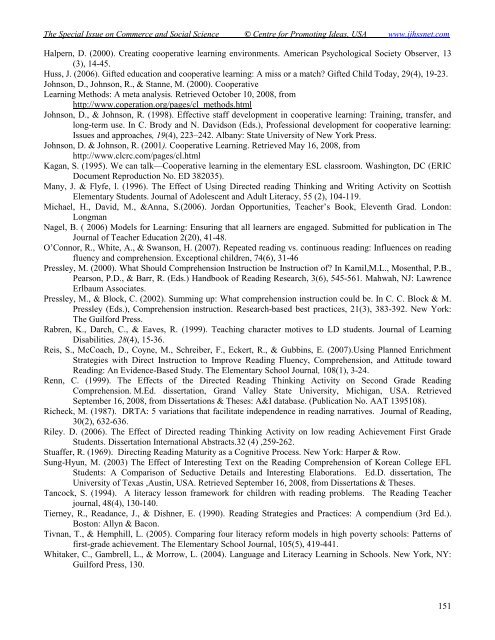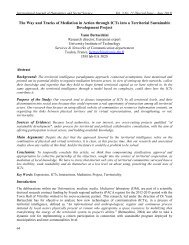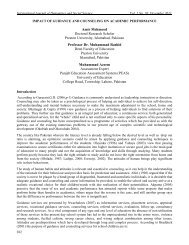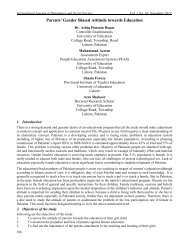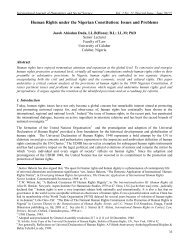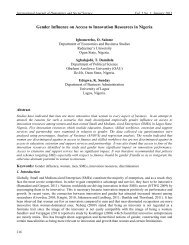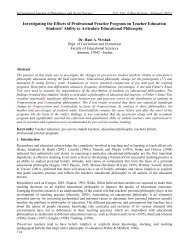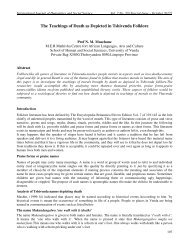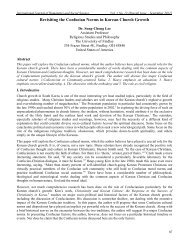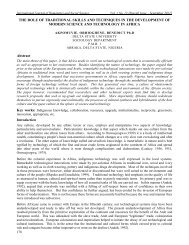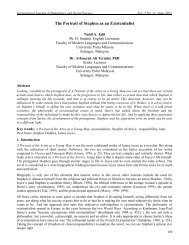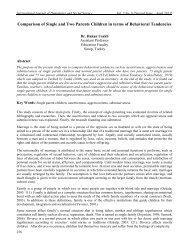The Effect of the Directed Reading Thinking Activity through ...
The Effect of the Directed Reading Thinking Activity through ...
The Effect of the Directed Reading Thinking Activity through ...
You also want an ePaper? Increase the reach of your titles
YUMPU automatically turns print PDFs into web optimized ePapers that Google loves.
<strong>The</strong> Special Issue on Commerce and Social Science © Centre for Promoting Ideas, USA www.ijhssnet.com<br />
Halpern, D. (2000). Creating cooperative learning environments. American Psychological Society Observer, 13<br />
(3), 14-45.<br />
Huss, J. (2006). Gifted education and cooperative learning: A miss or a match? Gifted Child Today, 29(4), 19-23.<br />
Johnson, D., Johnson, R., & Stanne, M. (2000). Cooperative<br />
Learning Methods: A meta analysis. Retrieved October 10, 2008, from<br />
http://www.coperation.org/pages/cl_methods.html<br />
Johnson, D., & Johnson, R. (1998). <strong>Effect</strong>ive staff development in cooperative learning: Training, transfer, and<br />
long-term use. In C. Brody and N. Davidson (Eds.), Pr<strong>of</strong>essional development for cooperative learning:<br />
Issues and approaches, 19(4), 223–242. Albany: State University <strong>of</strong> New York Press.<br />
Johnson, D. & Johnson, R. (2001). Cooperative Learning. Retrieved May 16, 2008, from<br />
http://www.clcrc.com/pages/cl.html<br />
Kagan, S. (1995). We can talk—Cooperative learning in <strong>the</strong> elementary ESL classroom. Washington, DC (ERIC<br />
Document Reproduction No. ED 382035).<br />
Many, J. & Flyfe, l. (1996). <strong>The</strong> <strong>Effect</strong> <strong>of</strong> Using <strong>Directed</strong> reading <strong>Thinking</strong> and Writing <strong>Activity</strong> on Scottish<br />
Elementary Students. Journal <strong>of</strong> Adolescent and Adult Literacy, 55 (2), 104-119.<br />
Michael, H., David, M., &Anna, S.(2006). Jordan Opportunities, Teacher’s Book, Eleventh Grad. London:<br />
Longman<br />
Nagel, B. ( 2006) Models for Learning: Ensuring that all learners are engaged. Submitted for publication in <strong>The</strong><br />
Journal <strong>of</strong> Teacher Education 2(20), 41-48.<br />
O’Connor, R., White, A., & Swanson, H. (7002). Repeated reading vs. continuous reading: Influences on reading<br />
fluency and comprehension. Exceptional children, 74(6), 31-46<br />
Pressley, M. (2000). What Should Comprehension Instruction be Instruction <strong>of</strong>? In Kamil,M.L., Mosenthal, P.B.,<br />
Pearson, P.D., & Barr, R. (Eds.) Handbook <strong>of</strong> <strong>Reading</strong> Research, 3(6), 545-561. Mahwah, NJ: Lawrence<br />
Erlbaum Associates.<br />
Pressley, M., & Block, C. (2002). Summing up: What comprehension instruction could be. In C. C. Block & M.<br />
Pressley (Eds.), Comprehension instruction. Research-based best practices, 21(3), 383-392. New York:<br />
<strong>The</strong> Guilford Press.<br />
Rabren, K., Darch, C., & Eaves, R. (1999). Teaching character motives to LD students. Journal <strong>of</strong> Learning<br />
Disabilities, 28(4), 15-36.<br />
Reis, S., McCoach, D., Coyne, M., Schreiber, F., Eckert, R., & Gubbins, E. (2007).Using Planned Enrichment<br />
Strategies with Direct Instruction to Improve <strong>Reading</strong> Fluency, Comprehension, and Attitude toward<br />
<strong>Reading</strong>: An Evidence-Based Study. <strong>The</strong> Elementary School Journal, 108(1), 3-24.<br />
Renn, C. (1999). <strong>The</strong> <strong>Effect</strong>s <strong>of</strong> <strong>the</strong> <strong>Directed</strong> <strong>Reading</strong> <strong>Thinking</strong> <strong>Activity</strong> on Second Grade <strong>Reading</strong><br />
Comprehension. M.Ed. dissertation, Grand Valley State University, Michigan, USA. Retrieved<br />
September 16, 2008, from Dissertations & <strong>The</strong>ses: A&I database. (Publication No. AAT 1395108).<br />
Richeck, M. (1987). DRTA: 5 variations that facilitate independence in reading narratives. Journal <strong>of</strong> <strong>Reading</strong>,<br />
30(2), 632-636.<br />
Riley. D. (2006). <strong>The</strong> <strong>Effect</strong> <strong>of</strong> <strong>Directed</strong> reading <strong>Thinking</strong> <strong>Activity</strong> on low reading Achievement First Grade<br />
Students. Dissertation International Abstracts.32 (4) ,259-262.<br />
Stuaffer, R. (1969). Directing <strong>Reading</strong> Maturity as a Cognitive Process. New York: Harper & Row.<br />
Sung-Hyun, M. (2003) <strong>The</strong> <strong>Effect</strong> <strong>of</strong> Interesting Text on <strong>the</strong> <strong>Reading</strong> Comprehension <strong>of</strong> Korean College EFL<br />
Students: A Comparison <strong>of</strong> Seductive Details and Interesting Elaborations. Ed.D. dissertation, <strong>The</strong><br />
University <strong>of</strong> Texas ,Austin, USA. Retrieved September 16, 2008, from Dissertations & <strong>The</strong>ses.<br />
Tancock, S. (1994). A literacy lesson framework for children with reading problems. <strong>The</strong> <strong>Reading</strong> Teacher<br />
journal, 48(4), 130-140.<br />
Tierney, R., Readance, J., & Dishner, E. (1990). <strong>Reading</strong> Strategies and Practices: A compendium (3rd Ed.).<br />
Boston: Allyn & Bacon.<br />
Tivnan, T., & Hemphill, L. (2005). Comparing four literacy reform models in high poverty schools: Patterns <strong>of</strong><br />
first-grade achievement. <strong>The</strong> Elementary School Journal, 105(5), 419-441.<br />
Whitaker, C., Gambrell, L., & Morrow, L. (2004). Language and Literacy Learning in Schools. New York, NY:<br />
Guilford Press, 130.<br />
151


